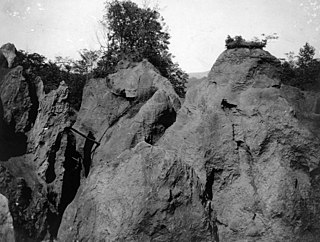| Genesee Group | |
|---|---|
| Stratigraphic range: Frasnian | |
| Type | Group |
| Unit of | Frasnian |
| Sub-units |
|
| Underlies | Sonyea Group |
| Overlies | Tully Limestone |
| Location | |
| Region | New York, Pennsylvania |
| Country | United States |
The Genesee Group [1] is a geologic formation in Pennsylvania. It preserves fossils dating back to the Devonian period.
It includes submembers: [1]

The Marcellus Formation or the Marcellus Shale is a Middle Devonian age unit of sedimentary rock found in eastern North America. Named for a distinctive outcrop near the village of Marcellus, New York, in the United States, it extends throughout much of the Appalachian Basin.
The Traverse Group is a geologic group in Michigan, comprising middle Devonian limestones with calcareous shale components. Its marine fossils notably include Michigan's state stone, the Petoskey stone, among other corals and records of ancient marine life. A range of trilobites has also been found in the Traverse Group.

The Waverly Group is a geologic group in Michigan and Ohio. It preserves fossils dating back to the Carboniferous period.

The Hinton Formation is a geologic formation in West Virginia. It preserves fossils dating back to the Carboniferous period. It is mainly made up of limestone, sandstone, and shale.

The Harrodsburg Limestone is a geologic formation, a member of the Sanders Group of Indiana Limestone, of Mississippian age. It was named for Harrodsburg in southern Monroe County, Indiana by T. C. Hopkins and C. E. Siebenthal. It is made up primarily of calcarenite and calcirudite. It also may include some beds of dolomite and shale.
The Whitesburg Formation is a dark limestone with interbedded shales geologic formation in Tennessee and Virginia. It preserves fossils dating back to the Ordovician period.

The Sonyea Group is a geologic group in the northern part of the Appalachian Basin. It preserves fossils dating back to the Devonian period.
The Java Formation is a geologic formation in Kentucky, New York, Ohio, Pennsylvania, Tennessee, Virginia, West Virginia. It preserves fossils dating back to the Devonian period. The formation comprises the Pipe Creek Shale, Wiscoy Sandstone Member in New York, and Hanover Shale Member except in Tennessee.

The Kinzers Formation is a geologic formation in Pennsylvania. It preserves fossils dating back to the Cambrian Period.

The Tomstown Dolomite or Tomstown Formation is a geologic formation in Maryland, Pennsylvania, Virginia and West Virginia. It preserves fossils dating to the Cambrian Period.
The Portage Group, also known as the Nunda Group, Portage Formation, or Portage Shale, are all obsolete, now abandoned, names for fossiliferous, sedimentary strata of Late Devonian age in New York. It was named for extensive outcrops found along the Genesee River in an area formerly included in town of Nunda, now in Portage, New York in the southwest corner of Livingston County.
The Genundewa Limestone is a geologic formation in New York. It preserves fossils dating back to the Devonian period.
The Oneonta Formation is a geologic formation in New York. It preserves fossils dating back to the Devonian period.
The Penn Yan Formation is a geologic formation in New York. It preserves fossils dating back to the Devonian period.
The West River Shale is a geologic formation in New York. It preserves fossils dating back to the Devonian period.

The Gros Ventre Formation is a geologic formation in Wyoming, USA. It preserves fossils dating back to the Cambrian period. The Gros Ventre consists of three main members; the Wolsey Shale, the Death Canyon Limestone, and the Park Shale.
The Mount Whyte Formation is a stratigraphic unit that is present on the western edge of the Western Canada Sedimentary Basin in the southern Canadian Rockies and the adjacent southwestern Alberta plains. It was deposited during Middle Cambrian time and consists of shale interbedded with other siliciclastic rock types and limestones. It was named for Mount Whyte in Banff National Park by Charles Doolittle Walcott, the discoverer of the Burgess shale fossils, and it includes several genera of fossil trilobites.

The Dent Group is a group of Upper Ordovician sedimentary and volcanic rocks in north-west England. It is the lowermost part of the Windermere Supergroup, which was deposited in the foreland basin formed during the collision between Laurentia and Avalonia. It lies unconformably on the Borrowdale Volcanic Group. This unit was previously known as the Coniston Limestone Group or Coniston Limestone Formation and should not be confused with the significantly younger Coniston Group.
The Pulteney Shale is a geologic formation in New York. It preserves fossils dating back to the Devonian period.